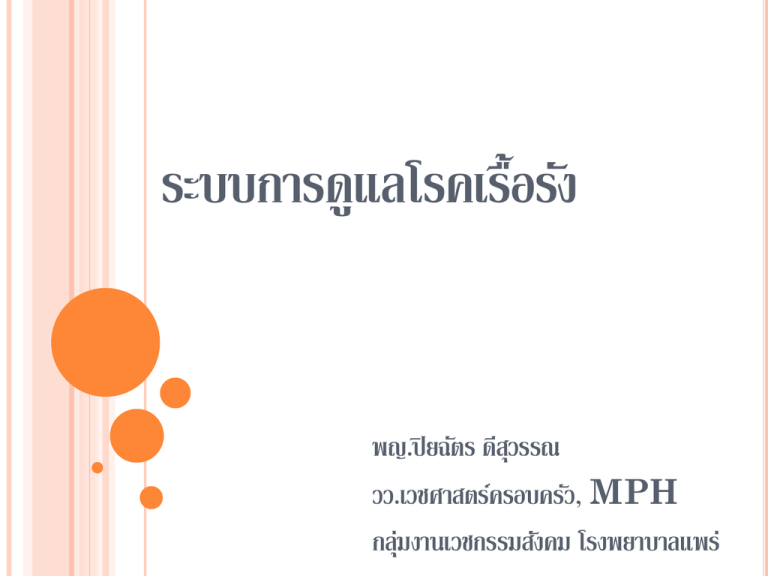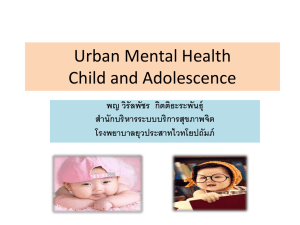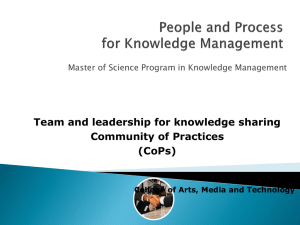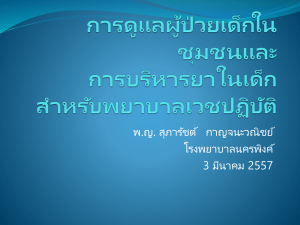คลิ๊กที่นี่เพื่ออ่านรายละเอียด
advertisement

ระบบการดูแลโรคเรื้อรัง พญ.ปิ ยฉัตร ดีสวุ รรณ วว.เวชศาสตร์ครอบครัว, MPH กลุ่มงานเวชกรรมสังคม โรงพยาบาลแพร่ สถานการณ์โลก …โรคเรื้อรัง 2/3 ของการเสียชีวติ เกิดจากโรคเรื้อรัง ราว 80% ของการเสียชีวต ิ จากโรคเรื้อรังพบในประเทศด้อยและ กาลังพัฒนา ¼ ของการเสียชีวต ิ จากโรคเรื้อรังเกิดกับประชากรอายุนอ้ ยกว่า 60 ปี โรคเรื้อรังที่เป็ นปั ญหาสาคัญของโลก Cardiovascular disease (CVD) Diabetes mellitus (DM) Cancer (CA) Chronic respiratory disease TOP 10 CAUSES OF DALY LOSS, 2004, THAILAND Men 1. HIV 2. Traffic accident 3. Stroke 4. Alcohol dependence 5. Liver cancer 6. Ischemic heart disease 7. COPD 8. DM 9. Cirrhosis 10. Depression 1. 2. 3. 4. 5. 6. 7. 8. 9. 10. Women Stroke HIV DM Depression Ischemic heart disease OA Traffic accident Liver cancer Deafness Anemia Bundhamcharoen K, BMC public health, 2011 10 อันดับแรกของสาเหตุการตายของชาวไทย ปี 2549-2553 1. 2. 3. 4. 5. มะเร็งและเนื้องอกทุกชนิด อุบตั เิ หตุ โรคหัวใจ ความดันสูงและโรคหลอด เลือดสมอง ปอดอักเสบ 6. โรคไต 7. โรคตับและตับอ่อน 8. การฆ่าตัวตาย 9. เบาหวาน 10. โรคเอดส์ สำนักนโยบำยและยุทธศำสตร์ สำนักงำนปลัดกระทรวงสำธำรณสุ ข พฤติกรรมเสีย่ งที่สาคัญ (tobacco use) อาหารไม่เหมาะสม (unhealthy diet) ไม่ออกกาลังกาย (physical inactivity) ่ สุรา (harmful use of alcohol) ดืม การสูบบุหรี่ การสูบบุหรี่ มีผเู ้ สียชีวต ิ จากบุหรี่ ราว 6 ล้านคนต่อปี บุหรีเ่ ป็ นสาเหตุของ 71% ของมะเร็งปอด 42% ของโรคระบบทางเดินหายใจเรื้อรัง 10% ของโรคหลอดเลือดหัวใจ (WHO 2010) บริโภคอาหารไม่เหมาะสม บริโภคผัก ผลไม้ ทีเ่ พียงพอ สามารถลดโอกาสการเกิดโรคหัวใจและ หลอดเลือด, มะเร็งกระเพาะอาหาร และมะเร็งลาไส้ใหญ่ได้ ่ งของความดันโลหิตสูง และโรคหัวใจและ การทานเค็ม เพิ่มความเสีย หลอดเลือด ่ ตัวสูง เพิ่มความเสีย่ งของโรคหัวใจและหลอดเลือด ทานไขมันอิม ่ งต่อ โรคเบาหวาน หัวใจและหลอดเลือด ภาวะอ้วน เพิ่มความเสีย ไม่ออกกาลังกาย ประชากร กาย 3.2 ล้านคนต่อปี เสียชีวติ จากการไม่ออกกาลัง ดืม่ สุรา มีผเู ้ สียชีวต ิ จากการดืม่ สุรา ประมาณ 2.3 ล้านคนต่อปี วงจรร้ายของการเกิดโรคเรื้อรัง (VICIOUS CYCLE) พฤติกรรมเสี่ ยง บุหรี่ ,เหล้ำ,ไม่ออกกำลังกำย, ทำนอำหำรไม่เหมำะสม ควำมยำกจน (poverty) โรคเรื้ อรัง (WHO 2010) ธรรมชาติของการเกิดโรค (AFMC) ระดับของการป้องกันโรค ปฐมภูมิ (Primary) ทุติยภูมิ (Secondary) จุดเริ่มต้ นของโรค ตติยภูมิ (Tertiary) วินิจฉัยโรค ยังไม่ เป็ นโรค เป็ นโรคแต่ ไม่ มีอาการ มีอาการของโรคแล้ว กาจัดปัจจัยเสี่ ยง ลดภาวะแทรกซ้ อน ค้ นพบโรคตั้งแต่ เริ่มต้ นและรักษา Fletcher และคณะ, 1996 มุมมองที่แตกต่างจากการดูแลโรคฉับพลัน เน้นการส่งเสริมสุขภาพ ควบคูก่ ารทาให้มีคณ ุ ภาพชีวติ ทีด่ ี เน้นการเสริมศักยภาพของผูป ้ ่ วยและครอบครัว 3 มาตรการสาคัญในการลดโรคเรื้อรัง ในอนาคต ลดพฤติกรรมเสีย่ ง (eliminate risk factor) ค้นหำโรคแต่เริ่ มแรก (Early detection) กำรรักษำแต่เริ่ มแรก (Timely treatment) โรคเรื้ อรังลดลง , ชะลอกำรเกิดภำวะแทรกซ้อน, ลดอัตรำกำรเสี ยชีวิตจำกโรคเรื้ อรัง ระบบบริการ 3 ระดับ Continuity of care Tertiary care เน้นรักษำโรคร้ำย ดูแลผูป้ ่ วยที่มีภำวะแทรกซ้อน ประคับประคอง ลดอันตรำยและควำมพิกำร Secondary care เป้ ำหมำย: รักษำ ดูแลต่อเนื่อง ปรับพฤติกรรมให้เหมำะสม ป้ องกันโรคแทรก ส่ งเสริ มควำมสำมำรถ ในกำรดูแลตนเอง Primary care เป้ ำหมำย: สร้ำงภูมิคุม้ กัน ป้ องกันไม่ให้เกิดโรค ลดพฤติกรรมเสี่ ยง ในกลุ่มเสี่ ยงและกลุ่มประชำกรทัว่ ไป กิจกรรม: เน้นให้ควำมรู ้ ควำมเข้ำใจ สร้ำงควำมตระหนักและละเว้นปัจจัยเสี่ ยง ปั ญหาที่พบในระบบบริการแต่ละระดับ Tertiary care: มีกำรตรวจสำรพัดอย่ำง เน้นกำรจ่ำยยำมำก กำรตรวจเลือดและ คัดกรองภำวะแทรกซ้อนยังไม่เพียงพอ กำรดูแลอย่ำงครบวงจรมีนอ้ ย ขำดเรื่ องกำรสร้ำงควำมสำมำรถในกำรดูแลรักษำผูป้ ่ วย Secondary care: โรงพยำบำลแออัด ผูป้ ่ วยมำก ขำดควำมต่อเนื่อง เน้นกำรจ่ำยยำมำกกว่ำกำรดูแลผูป้ ่ วย ให้ควำมรู ้เป็ นชุดเหมือนกันทุกครั้งและทุกคน กำรสนับสนุนให้ประชำชนดูแลตนเองยังมีนอ้ ย Primary care : คัดกรองเกือบครอบคลุม แต่ไม่ได้จดั กำรต่อ ในกำรปรับพฤติกรรมอย่ำงต่อเนื่อง กำรดำเนินงำนส่ งเสริ ม ป้ องกัน ทำเป็ นกิจกรรมๆ เป็ นโครงกำร มำกกว่ำ กำรเน้นกลุ่มประชำกรที่ชดั เจน กระจัดกระจำย ทำให้ไม่ครอบคลุม กำรช่วยสนับสนุนปรับพฤติกรรมไม่มีควำมต่อเนื่อง หรื อเข้มข้นเพียงพอ กำรป้ องกันจึมีปัญหำอยู่ มำก Primary care รำกฐำนของระบบกำรดูแลผูป้ ่ วยโรคเรื้ อรัง โรงพยาบาลส่งเสริมสุขภาพตาบล ตั้งอยูใ่ นชุมชน สถำนบริ กำรใกล้บำ้ น ใกล้ใจ จุดเด่น ผูป้ ่ วย ผูร้ ับบริ กำรเข้ำถึงสะดวก ผูใ้ ห้บริ กำร อบอุ่น เป็ นกันเอง รู ้จกั กัน ทั้งครอบครัว ให้กำรดูแลทุกระดับ บุคคล-ครอบครัว-ชุมชน มองปัญหำสุ ขภำพแบบองค์รวม ไม่ เน้ นการให้ ยา แนวทางการปฏิบตั งิ านในโรงพยาบาลส่งเสริมสุขภาพตาบล 1.กำรสำรวจประชำกร เพื่อคัดกรองควำมเสี่ ยง และค้นหำผูป้ ่ วย 2.กำรจัดกำรระบบข้อมูล 3.กำรจัดบริ กำรในโรงพยำบำลส่ งเสริ มสุ ขภำพตำบล 4.กำรจัดบริ กำรที่บำ้ น 5.กำรดำเนินงำนในชุมชน 6.กำรจัดระบบสนับสนุน และกำรเชื่อมต่อระหว่ำง โรงพยำบำลชุมชนกับโรงพยำบำลส่ งเสริ มสุ ขภำพตำบล ระดับบุคคล-ครอบครั ว-ชุมชน Individual-family-community ประสบการณ์การดูแลผูป้ ่ วยโรคเรื้อรังรูปแบบต่างๆ THE UNITED KINGDOM Case management in England Evercare programme in England - Program for elderly people -Use specialist nurses (advanced practice nurses) monitor and coordinate the care of patients at risk according to individual care plans -Aim to improve patient’s functional status and quality of life and avoid hospital admission 5 core principles 1. Apply an individualized, whole-person approach to care of older persons with all interventions focused on promoting maximal function, independence, comfort, and quality of life 2. Use primary care as the central organizing force for health care across the continuum 3. Provide care in the least invasive manner, in the least intensive setting 4. Avoid adverse effects of medications and polypharmacy 5. Use data to strengthen decision-making Successes of the program and lessons learned Identification of an “invisible” high risk population created many new opportunities to improve care. The nurses’ success in assuming their expanded primary care role has resulted in better care for patients. Evercare has been a catalyst for accelerating plans to reengineer the nursing workforce. In addition to GPs who served as mentors, doctors in acute care settings (consultants and specialist registrans) volunteered time to help the APNs build clinical confidence in their new role. Communication and collaboration among professionals in different parts of the health care system improved;this was specially true between secondary and community care The PCTs gained experience in retrieving data,which help them extract and use meaningful data in the future HEALTH CARE SYSTEM IN AUSTRALIA Health Status Average life expectancy at birth was 83.3 years for women and 78.5 years for men (2003-05) Life expectancy at birth for indigenous population is about 17 years or less. Fertility rate was 1.8 births per female in 2005–06, a slight increase from the preceding 5 years. MAJOR HEALTH PROBLEMS Arthritis Asthma Cancer Cardiovascular Diabetes Injury Mental health Obesity Components of the Australian Health Care System 1. 2. 3. 4. Australian Government State and territory government Local Government Others WHO PAYS FOR HEALTH SERVICES? 70% of total expenditure in Australia is funded by government (2/3 by Australian government and 1/3 by state, territory and local government) Australian government : Medicare and PBS Medicare- services provided by doctors and optometrist and other allied health professionals PBS- high proportion of prescription medication bought from pharmacies Health services funding and responsibility SERVICES AND SUBSIDIES First contact : general medical practitioner (GP) Patients can choose their own GP and are reimbursed for all or part of the GP’s fee by Medicare Patients can be referred to specialized care by GP Emergency : public hospital Public hospital emergency and outpatient services are provided free of charge, as is inpatient treatment for public patients Patients admitted to a public hospital can choose to be treated there as either public or private patients, and others can choose to be admitted directly to a private hospital Family medical center Chemist HOSPITAL Prince of Wales hospital Children hospital MEDICARE Provides the mechanism for the funding of two key groups : public hospitals and doctors Aim : to reduce or remove financial barriers to the access of health care for all Australians Mostly funded from general taxation All consumers access to free inpatient treatment Commonwealth administer the Medicare Rebates of 85% of the fee for out-of hospital medical services and 75% for private inpatients Doctors send their bill directly to Medicare and accept the rebate in full settlement Providing GP with incentives for completing immunization protocols THE PHARMACEUTICAL BENEFITS SCHEME (PBS) The PBS provides subsidized prescription medicines for the Australian population Co-payment Encourage the use of the lowest cost brand If the patient chooses, or is prescribed, a more expensive brand, they will need to pay the difference between that brand and the lowest priced one, in addition to the usual PBS patient contribution Drug lists on the PBS : proved for efficacy and health economic criteria PRIVATE HEALTH INSURANCE Cover services in private hospitals and private patients in public hospitals A wide range of allied health and other professional services, including some alternative/complementary health services Allowing funds to provide ‘gap’ payments for inpatient medical services 30% rebate for the cost of private health insurance Community rating Life time health cover WHO REGULATES HEALTH SERVICES? State and territory government : licensing or registering private hospitals, medical practitioners and other health professionals, operation of public hospitals, industry regulations such as alcohol and tobacco products Australian government : overseeing safety and quality of pharmaceutical and therapeutic goods, regulating private health insurance industry, international quarantine OTHER KEY PARTS OF THE SYSTEM Research and statistical agencies Consumer and advocacy groups Professional associations Universities and Hospitals Voluntary agencies PRIMARY HEALTH CARE Problems of health inequalities Medical services in the community should be moulded to respond to prevailing health needs of the community COPC Health promotion Disease prevention and early diagnosis and medical treatment Primary health care providers - screening, individual, group health education, community development, advocacy, Involvement in public health planning - General practitioners, - community health centers บทเรี ยนกำรจัดกำรโรคเรื้ อรัง ในชุมชน กรณี อบต.มะขุนหวำน อ.สันป่ ำตอง จ.เชียงใหม่ นำโดย นำยนภดล ทรำยมูล รองประธำน กองทุนหลักประกันสุ ขภำพ องค์กำรบริ หำรส่ วนตำบลมะขุนหวำน - ตำบลมะขุนหวำน มีผปู ้ ่ วยเบำหวำน และ ควำมดันสู ง รวม 327 คน (เบำหวำน 132) จำกประชำกร 5859 คน - รพ.สต. มะขุนหวำน มีบุคลำกร 3 คน มีอสม. 129 คน - มีแพทย์ออกตรวจประจำเดือนละ 1 ครั้ง -ตำบลมะขุนหวำน พื้นที่ 10 กว่ำตำรำงกิโลเมตร -โอกำส : ข้อตกลง ร่ วมระหว่ำง อบต. และ สปสช. จัดทำกองทุนสุ ขภำพตำบล - ทุนทำงสังคม: ชมรมปั่ นจักรยำน, ชมรมอำสำสมัคร, ชมรมไทจี๋, ชี่กง, ชมรม ออกกำลังกำย, ชมรมผูพ้ ิกำร, ชมรมสูงอำยุ ฯลฯ - สำเหตุกำรตำย: เบำหวำน ควำมดันโลหิ ตสูง และโรคแทรก - ใช้แผนที่ทำงเดินยุทธศำสตร์ (SRM: Strategic route map) ใช้ในกำร ดำเนินงำนโรคเรื้ อรัง - อบต. ได้แยกแผนยุทธศำสตร์ดำ้ นสุ ขภำพ ออกจำกแผนยุทธศำสตร์หลักของ ท้องถิ่น - สร้ำง แผนที่ทำงเดินยุทธศำสตร์ปฏิบตั ิกำร SLM: Strategic Linkage Model Construction มุ่งหวังให้ประชำชนปรับพฤติกรรม -Road map: บุคลำกร แกนนำที่มีสมรรถนะที่เหมำะสม วิเครำะห์ปัญหำ และทำแผน - ระบบบริ หำรจัดกำรองค์กรและภำคีเครื อข่ำยมีประสิ ทธิ ภำพ โดยประกำศ “เรำจะควบคุมเบำหวำนและควำมดันโลหิ ตสู ง ซึ่ งเป็ นโรคเรื้ อรังในตำบล” โดยประกำศต่อหน้ำสำธำรณชน -หน่วยงำนภำครัฐทุกระดับสนับสนุนและประสำนงำนอย่ำงเข้มแข็ง - อบต. สนับสนุนงบประมำณโครงกำรให้กองทุนฯ ร้อยละ 70 - มำตรกำรทำงสังคม เชิง positive เช่น ทุกหลังคำเรื อนมีป้ำย เตือนลดเครื่ องปรุ ง ลดหวำน มัน เค็ม จัดกิจกรรมออกกำลังกำยทุกสัปดำห์, จัดทำอำหำรสุ ขภำพในงำนพิธี , ลด เครื่ องดื่มแอลกอฮอล์, ลดกำรดื่มน้ ำอัดลม, มำตรกำรปลูกผักพื้นบ้ำนและ สมุนไพรเพื่อบริ โภค ใช้แนวคิดสุ ขภำพดีคู่ควำมพอเพียง -ภำคที่เกี่ยวข้องอื่นเช่น โรงเรี ยนในพื้นที่ มีมำตรกำรไม่ให้จำหน่ำยขนม กรุ บกรอบในโรงเรี ยน สร้ำงบุคคลต้นแบบดูแลสุ ขภำพ - กำรมีระบบเฝ้ ำระวังที่มีประสิ ทธิภำพ ผลที่เกิดขึ้น ชมรมออกกาลังกายเกิดขึ้นทุกหมูบ ่ า้ น ชมรมผูป ้ ่ วยเบาหวานและความดันโลหิตสูง (เพื่อนสอนเพื่อน) มิตรภาพบาบัด โรงเรียนนวัตกรรมสุขภาพชุมชน สร้างทีมนักจัดการสุขภาพตาบลมะขุนหวานทุกหมูบ ่ า้ น เกิดการ เรียนรูเ้ รือ่ งการสร้างการมีสว่ นร่วมของชุมชน การเรียนรูด้ า้ นอาชีพ เพิ่มศักยภาพอสม.ด้านคอมพิวเตอร์ ปั จจัยแห่งความสาเร็จ 1.ใช้แผนที่ทำงเดินยุทธศำสตร์เป็ นเครื่ องมือ 2.สร้ำงควำมเข้มแข็งทีมตำบล 3.เป็ นพื้นที่ตน้ แบบ 4.กำรมีส่วนร่ วมของภำคเครื อข่ำยทุกภำคส่ วน 5.กำรพัฒนำอย่ำงเป็ นระบบและต่อเนื่อง 6.เกิดนวัตกรรมในชุมชน 7.บรรยำกำศ วัฒนธรรม กำรทำงำนเอื้ออำนวย กำรให้กำรยอมรับกันและ กันของอำสำสมัคร ระบบการจัดการเพือ่ การดูแลและป้องกันโรคเบาหวานในชุมชน เครือข่าย อ.เมือง จ.พิษณุโลก ประชำกรเขตอำเภอเมืองพิษณุโลก 1.7 แสนคน เครื อข่ำยปฐมภูมิ อ.เมือง 5 cup โรงพยำบำลพุทธชินรำช (20 แห่ง) โรงพยำบำลมหำวิทยำลัยนเรศวร (6 แห่ง) โรงพยำบำลค่ำยสมเด็จพระนเรศวรมหำรำช (1 แห่ง) เทศบำล (4 แห่ง) กองบิน 46 (1 แห่ง) หลักการในการพัฒนา 1.สร้ำงทีมร่ วมดูแลสุ ขภำพประชำชน 2.สร้ำงระบบเชื่อมโยง โดยมีศูนย์ประสำนงำนเชื่อมโยงเครื อข่ำย 3.สร้ำงพลังชุมชน โรงพยำบำล HAMIS (Hospital Advance Management Information System) คลินิกเบำหวำน ศูนย์สุขภำพเมือง คลินิกเบำหวำน อำยุรกรรม รพ.สต ต่ำงๆ -กิจกรรมส่ งเสริ มกำรดูแลผูป้ ่ วยที่นอนรพ. -กิจกรรมแพทย์ทำงเลือก เน้น กำรปรับเปลี่ยนพฤติกรรม -One day camp ในกลุ่มควบคุมไม่ได้ -มีกิจกรรมสร้ำงพลังอำนำจ ในกำรดูแลตนเอง (ชมรมเบำหวำน) ค้นหำคนต้นแบบในชุมชน หัวหมู่เบำหวำน -สหกรณ์สุขภำพ เงินค่ำตรวจน้ ำตำล ครั้งละ 3-5 บำท เงินที่ได้ เอำไปเยีย่ มผูป้ ่ วย -มีแพทย์หมุนเวียน - Clinical practice guideline 7 สุขภาพ อบต. รพ.สต. โรงพยำบำลพุทธชินรำช กำนัน/ผูใ้ หญ่บำ้ น คนต้นแบบ/หัวหมู่เบำหวำน ผูป้ ่ วยและครอบครัว อสม CHRONIC DISEASE SELF MANAGEMENT PROGRAM Standford University 6 week session of workshops, with weekly sessions of 2.5 hr Take place in community settings People with different chronic conditions attend together Facilitated by 2 trained leaders: 1 health care professional, non health care professionals with a chronic illness themselves Subjects: Technique to deal generic problems of chronic illness Appropriate exercise Appropriate use of medication Communicating effectively Nutrition Ways to evaluate new treatments Each participant receives a copy of companion book Living a healthy life with chronic conditions Audio relaxation tape Time for healing WHO กรอบแนวคิดในกำรพัฒนำระบบเพื่อดูแลผูท้ ี่มีปัญหำโรคเรื้ อรัง เชื่อมโยง ระบบบริ กำรสุ ขภำพ สนับสนุนกำรดูแลตนเอง จัดระบบและทีมบริ กำรที่ดี ให้ขอ้ มูลเพื่อดูแล ตัดสิ นใจ ติดตำม ประเมิน ชุมชน ผูน้ ำ สนับสนุน ประสำน ทรัพยำกร กระตุน้ ควำมตระหนัก ลดปมด้อย ร่ วมให้บริ กำรเสริ ม ผูป้ ่ วยและครอบครัว Prepared คู่มือกำรให้บริ กำรของ โรงพยำบำลส่ งเสริ มสุ ขภำพตำบล สถานการณ์โรคเรื้อรังในอาเภอลอง ระบบกำรจัดกำรโรคเรื้ อรังในพื้นที่รับผิดชอบ ควรเป็ นอย่ำงไรดี





